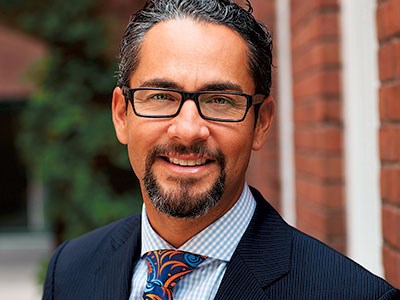The average Canadian just has to look at the country’s first economic engine — the fur trade — to find the origins of Indigenous peoples in business. But over time, the respect that had been established between Indigenous and non-Indigenous peoples from those early days eroded.
“We had great relationships, and those relationships got off track, and it’s been an unfortunate past 150 years,” said J.P. Gladu, president-CEO of the Canadian Council for Aboriginal Business (CCAB). “But things are changing, and they’re changing really rapidly, actually, and I’m quite proud of that.”
Speaking to an audience at Laurentian University in Sudbury on Feb. 4, Gladu shared insight into the importance of establishing sustainable partnerships between Indigenous and non-Indigenous businesses as part of the RBC Gkendassawin Trail Speaker series.
Indigenous peoples’ “forced hiatus” from business can be traced to the dilly-dallying of the provincial and federal governments, which treated First Nations peoples like a ping pong ball, lobbing the responsibility back and forth so that nothing got done, Gladu said.
It’s been frustrating both for Indigenous peoples trying to establish a presence in business and the businesses that are trying to build relationships with First Nations communities.
In recent years, Indigenous communities have used the law to establish their rights, but “digging in heels and going to the courts” is a poor way to effect change, Gladu believes.
“Everybody needs to start coming to the table to figure out these relationships and opportunities, and when we do that we can see incredible success,” Gladu said.
His home community of Bingwi Neyaashi Anishinaabek, for example, worked over a number of years to establish control of the Lake Nipigon Forest, going from zero per cent interest to 25 per cent interest to its current 100 per cent ownership.
And while it’s important to respect treaty rights, Gladu suggests if Indigenous peoples lead with their business acumen, treaty rights will fall into place.
“When we’re empowered as a people, when we get that foothold, we’re driving the economy, we’re a part of the economy, we feel like we’re actually contributing,” Gladu said. “That’s all we want.”
Indigenous people are the youngest, fastest growing demographic in Canada; in 2006, there were 37,000 Indigenous businesses in the country, coast to coast. This year, about $12 billion from Indigenous businesses will be injected into the country’s economy and the Aboriginal GDP is expected to reach $30 billion.
It’s an excellent time to empower the Indigenous workforce, and encourage young people to leave the reserves to earn an education before returning to start contributing to their communities, Gladu said.
There also needs to be more Indigenous representation in government and on company boards so the country doesn’t remain “pale, male and stale.”
“We have a real opportunity in this country; we’ve got a lot of strengths, and there’s a real opportunity to start aligning those strengths,” Gladu said. “We need to be cognizant of where our gaps are and try and fill in those gaps, but if we’re not open to change, we’re in real trouble.”




